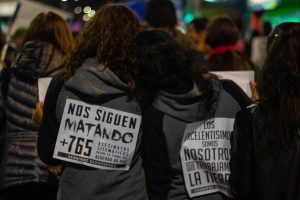Killings of Social Movement Leaders in Colombia
 This post was co-written by Valentina Rozo Ángel and Patrick Ball. The killing of social movement leaders has been widely documented in Colombia, particularly since the Peace Agreement in 2016. Documentation organizations do not agree on the exact number of killings. The varying number of reported killings sometimes confuses the public. Debate is diverted into narrow concerns about the accuracy of the data instead of concentrating on the policies and action needed to stop these homicides.
This post was co-written by Valentina Rozo Ángel and Patrick Ball. The killing of social movement leaders has been widely documented in Colombia, particularly since the Peace Agreement in 2016. Documentation organizations do not agree on the exact number of killings. The varying number of reported killings sometimes confuses the public. Debate is diverted into narrow concerns about the accuracy of the data instead of concentrating on the policies and action needed to stop these homicides.
Using multiple system estimation (MSE), we estimate the total population of social movement leaders killed in Colombia during 2018. This work expands our previous document “Asesinato de líderes sociales en 2016 y 2017: una estimación del universo,” in which we estimated the universe of victims for 2016 and 2017. [report in English] [report in Spanish]
MSE, or capture-recapture, is a method originally used in biology for estimating the size of animal populations. To understand the method intuitively, let’s suppose we want to estimate the number of bears who live in a forest. Every time that we “capture” a bear, we put an ID tag on it. If, after doing this exercise for a while, most of the bears that we capture have an ID, we can be pretty sure that the total bear population is very close to the ones that we have captured.
In the case of human rights there are many organizations that record killings. In our case, we take the data from six different organizations (including civil society, state and the UN), each of them with its own “captures” of social movement leaders killed for the estimating the total population.
We find that between 2016 and 2018, the estimated killings grew approximately 71% (from 166 to 284), but even with this increase, the documenting organizations have been able to cover almost every homicide. This supports the hypothesis that after the Peace Agreement, lethal violence against local leaders has worsened, a theory that has been widely discussed in Colombia.
We believe that it is important to note that although this report is focused on data and estimates, this story is about more than numbers. Each of the leaders who got killed was part of a community and worked to improve the rights and life of that community. Our goal with this document is to help to focus the debate on the necessity of protecting the lives of these individuals instead of arguing about the accuracy of each organization that monitors this issue.
Support for this project was provided by grants from The John D. and Catherine T. MacArthur Foundation, the Oak Foundation, the Open Society Foundations and an anonymous supporter. (For more information about HRDAG’s supporters, please see our Funding page.)
Image: Lukas Gaviria Mesa
El asesinato a líderes sociales ha sido ampliamente documentado desde la firma del Acuerdo de Paz. Sin embargo, las organizaciones que hacen un monitoreo a esta problemática no concuerdan sobre el número exacto de asesinatos, lo que puede llevar a confusiones. Entonces, muchas veces el debate público se desvía hacia lo precisa o imprecisa que es la información de cada organización en vez de concentrarse en las políticas y acciones necesarias para frenar estos homicidios.
En este documento usamos una estimación por sistemas múltiples (ESM) para estimar la población total de líderes sociales asesinados en 2018. Este trabajo expande nuestro informe “Asesinatos de líderes sociales en Colombia en 2016 y 2017: una estimación del universo”.
ESM o “captura recaptura” es un método utilizado originalmente en biología para estimar el tamaño de poblaciones animales. Para entender la intuición detrás, supongamos que queremos estimar el número de osos que vive en un páramo. Cada vez que “capturamos” a un oso le ponemos un ID en un collar. Si después de cierto tiempo la mayoría de osos que hemos capturado tienen un ID podemos estar bastante seguros de que la población total de osos es muy cercana a la que hemos capturado.
En el caso de los derechos humanos hay muchas organizaciones que hacen “capturas” de violaciones a estos derechos. En nuestro caso, tomamos los datos de seis distintas organizaciones para estimar la población total de líderes sociales asesinados.
Encontramos que entre 2016 y 2018 la población total de líderes sociales asesinados, es decir, incluyendo los casos no reportados, aumentó en aproximadamente 71%, pasando de 166 a 284. Este aumento en los homicidios a este grupo soporta la hipótesis de que después de que el Acuerdo de Paz la violencia letal contra los líderes sociales ha aumentado. Además, estimamos que con certeza la violencia letal contra los líderes aumentó en al menos 10% entre 2017 y 2018 y hay una probabilidad de 0,79 de que este incremento haya sido de 50% o más.
Por último, creemos que es importante resaltar que aunque este informe se concentra en datos y estimaciones, esta historia va mucho más allá de los números. Cada uno de los líderes que fue asesinado hacía parte de una comunidad y trabajaba por sus derechos. Nuestra meta con este informe es ayudar a concentrar el debate en la necesidad de proteger la vida de estas personas en vez de discutir sobre la exactitud del monitoreo de cada organización que hace un seguimiento a esta problemática.
